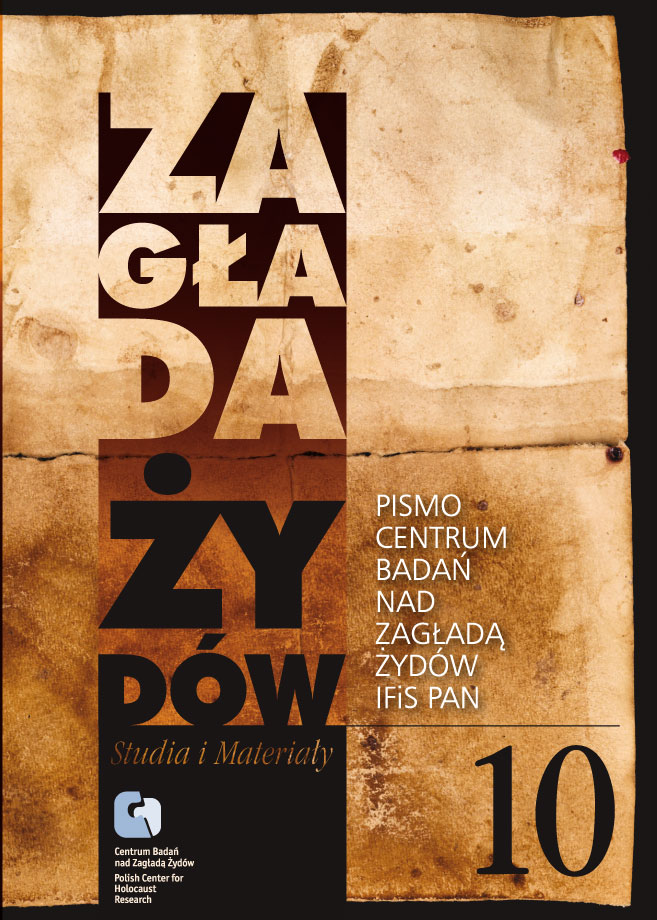Józef Kermisz (1907–2005) – twórca badań nad Szoa
Zagłada Żydów. Studia i Materiały, Nr 10 (2014), Strony: 304-316
Data zgłoszenia: 2020-10-22Data publikacji: 2014-12-01
 https://doi.org/10.32927/ZZSiM.526
https://doi.org/10.32927/ZZSiM.526
Abstrakt
Józef Kermisz (1907–2005) was a historian and an archivist who helped lay the foundations for Shoah research in Poland and Israel. In 1944 joined the Central Jewish Historical Commission where became the chief archivist. Since then his life has been devoted to retrieving wartime archival material. As archive director (in the Jewish Historical Institute in Poland and at Yad Vashem in Israel) he sought to develop an archive both for future historical research and for trials of suspected war criminal. He played a major role in discovering and preserving important documentation on the Shoah in Poland. Among his major professional achievements were preparing documentation for the prosecution in the Eichmann trial, and publishing Czerniakow’s diary and the full edition of the underground press of the Warsaw ghetto. He was one of the world’s leading experts on the Ringelblum Archive and other hidden Jewish documentation from the Holocaust. Kermisz left behind a legacy of a vast research infrastructure that he created and that will occupy scholars for generations.
Licencja
Prawa autorskie (c) 2014 Autor & "Zagłada Żydów. Studia i Materiały"

Utwór dostępny jest na licencji Creative Commons Uznanie autorstwa 4.0 Międzynarodowe.
https://creativecommons.org/licenses/by/4.0
Inne teksty tego samego autora
- Avner Shalev, Dan Michman, David Silberklang, Ścisła pamięć o Zagładzie w Muzeum Historii Holokaustu w Yad Vashem. Odpowiedź na artykuł Amosa Goldberga , Zagłada Żydów. Studia i Materiały: Nr 7 (2011)
Podobne artykuły
- Ewa Koźmińska-Frejlak, A Testimony of Silence… Interview with Jerzy Lewiński, a former functionary of the Order Service in the Warsaw ghetto , Zagłada Żydów. Studia i Materiały: 2008: Holocaust Studies and Materials
- Marek Bieńczyk, Parę uwag wokół Ceny Anny Bikont , Zagłada Żydów. Studia i Materiały: Nr 18 (2022)
- Barbara Engelking, Paweł Śpiewak , Zagłada Żydów. Studia i Materiały: Nr 19 (2023)
- Katarzyna Prot-Klinger, Krzysztof Szwajca, „Psychoterapia Ocalałych z Holokaustu w Polsce po 30 latach” , Zagłada Żydów. Studia i Materiały: Nr 20 (2024)
- Marcin Kula, Studium casusu (nawet jeśli niezwykłego), czy kulturowej historii powszechnej? Maria Ferenc, „Każdy pyta, co z nami będzie”. Mieszkańcy getta warszawskiego wobec wiadomości o wojnie i Zagładzie, Warszawa: ŻIH, 2021, 528 s. , Zagłada Żydów. Studia i Materiały: Nr 18 (2022)
- Grzegorz Krzywiec, A Polish Weininger? The Case of Julian Unszlicht (1883–1953) , Zagłada Żydów. Studia i Materiały: 2010: Holocaust Studies and Materials
- Anna Bikont, „Marzeniem pana Poteraja jak i moim jest, aby te niechlubne wydarzenia zostały opisane”. O zbrodni oddziału AK na Żydach ukrywających się na bagnach koło wsi Podosie w Łomżyńskiem , Zagłada Żydów. Studia i Materiały: Nr 18 (2022)
- Marcin Owsiński, Obóz żydowski w KL Stutthof i żydowscy więźniowie obozu w materiałach śledztwa i pierwszego procesu stutthofskiego w Gdańsku (1945–1946) , Zagłada Żydów. Studia i Materiały: Nr 19 (2023)
- Barbara Engelking, “We are competely dependent on them . . .” – relations between the helpers and the hiding as exemplified by Fela Fischbein’s diary , Zagłada Żydów. Studia i Materiały: 2010: Holocaust Studies and Materials
- Daniel Logemann, Europejski wymiar Zagłady w książkach niemieckich historyków, czyli jak pisać o przemocy wobec Żydów wymierzonej nie przez Niemców , Zagłada Żydów. Studia i Materiały: Nr 14 (2018)
<< < 30 31 32 33 34 35 36 37 38 39 40 41 42 43 44 45 46 47 48 49 50 51 52 53 54 55 56 57 58 59 60 61 62 63 64 65 66 67 68 69 70 > >>
Możesz również Rozpocznij zaawansowane wyszukiwanie podobieństw dla tego artykułu.
 English
English
 Język Polski
Język Polski








